Construction of a Framework for Supplier Selection: Outsourcing
VerifiedAdded on 2020/06/05
|105
|26759
|61
Project
AI Summary
This project focuses on constructing a framework for the selection of sustainable outsourcing suppliers, particularly within the context of the electronic manufacturing services (EMS) industry in China. The project begins with an introduction to the background and significance of outsourcing, emphasizing its role in gaining a competitive advantage through reduced costs, development schedules, and improved product quality. A comprehensive literature review examines relevant concepts such as the balance scorecard, the drawbacks of traditional methods, and the application of the Analytic Hierarchy Process (AHP) for supplier evaluation. The methodology section outlines the design process, including strategic analysis, supplier coding, and implementation phases. A case study applies the framework to a real-world scenario, analyzing the company's performance using a balance scorecard. The results and discussion chapter evaluates the company's performance, followed by a conclusion summarizing the project's achievements, limitations, and recommendations for future research. The project emphasizes the importance of vendor management, long-term supplier relationships, and the impact of factors such as rising labor costs in China on outsourcing strategies. The framework aims to provide a systematic tool for evaluating and selecting suppliers, ultimately contributing to the standardization of supplier selection processes.
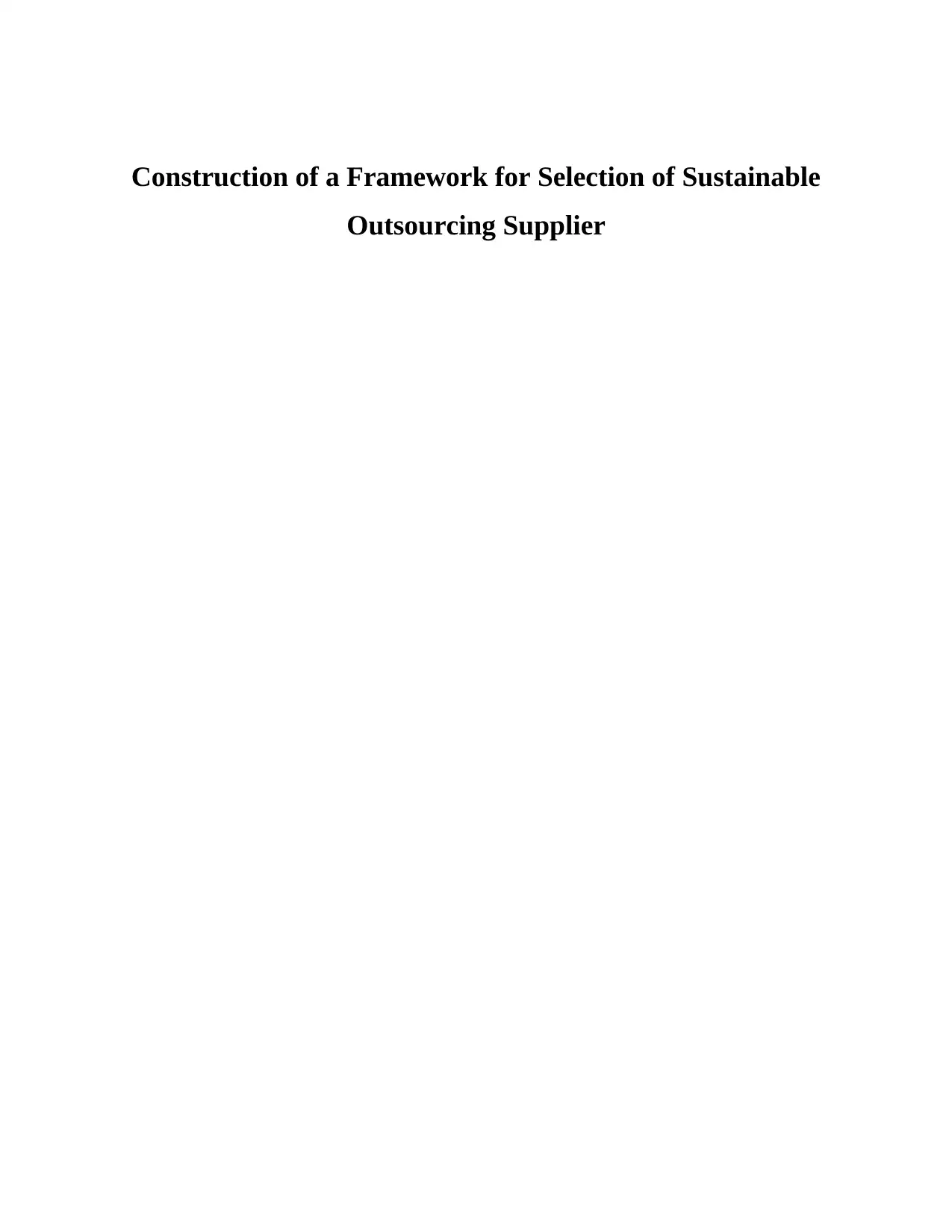
Construction of a Framework for Selection of Sustainable
Outsourcing Supplier
Outsourcing Supplier
Paraphrase This Document
Need a fresh take? Get an instant paraphrase of this document with our AI Paraphraser
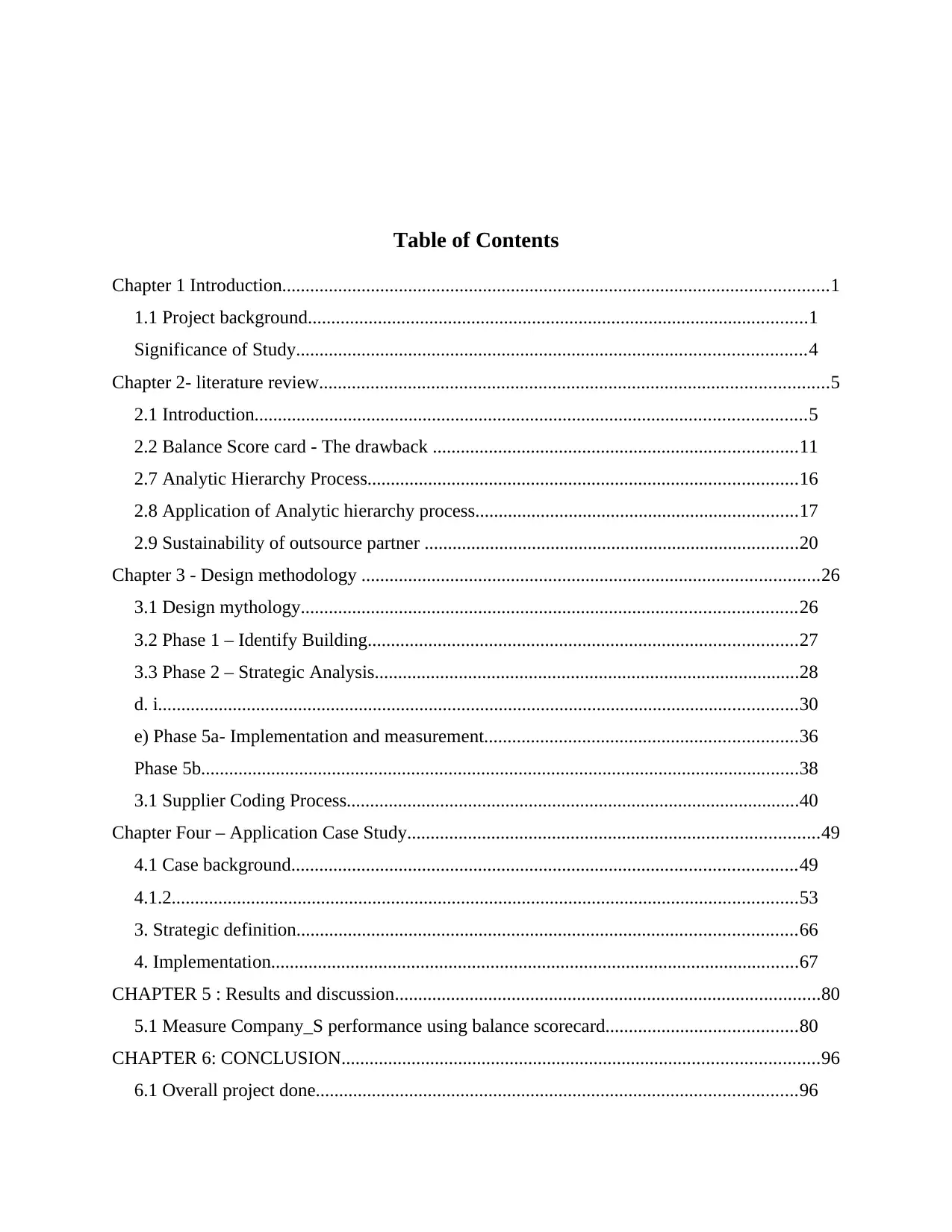
Table of Contents
Chapter 1 Introduction.....................................................................................................................1
1.1 Project background...........................................................................................................1
Significance of Study.............................................................................................................4
Chapter 2- literature review.............................................................................................................5
2.1 Introduction......................................................................................................................5
2.2 Balance Score card - The drawback ..............................................................................11
2.7 Analytic Hierarchy Process............................................................................................16
2.8 Application of Analytic hierarchy process.....................................................................17
2.9 Sustainability of outsource partner ................................................................................20
Chapter 3 - Design methodology ..................................................................................................26
3.1 Design mythology..........................................................................................................26
3.2 Phase 1 – Identify Building............................................................................................27
3.3 Phase 2 – Strategic Analysis...........................................................................................28
d. i.........................................................................................................................................30
e) Phase 5a- Implementation and measurement...................................................................36
Phase 5b................................................................................................................................38
3.1 Supplier Coding Process.................................................................................................40
Chapter Four – Application Case Study........................................................................................49
4.1 Case background............................................................................................................49
4.1.2......................................................................................................................................53
3. Strategic definition...........................................................................................................66
4. Implementation.................................................................................................................67
CHAPTER 5 : Results and discussion...........................................................................................80
5.1 Measure Company_S performance using balance scorecard.........................................80
CHAPTER 6: CONCLUSION......................................................................................................96
6.1 Overall project done.......................................................................................................96
Chapter 1 Introduction.....................................................................................................................1
1.1 Project background...........................................................................................................1
Significance of Study.............................................................................................................4
Chapter 2- literature review.............................................................................................................5
2.1 Introduction......................................................................................................................5
2.2 Balance Score card - The drawback ..............................................................................11
2.7 Analytic Hierarchy Process............................................................................................16
2.8 Application of Analytic hierarchy process.....................................................................17
2.9 Sustainability of outsource partner ................................................................................20
Chapter 3 - Design methodology ..................................................................................................26
3.1 Design mythology..........................................................................................................26
3.2 Phase 1 – Identify Building............................................................................................27
3.3 Phase 2 – Strategic Analysis...........................................................................................28
d. i.........................................................................................................................................30
e) Phase 5a- Implementation and measurement...................................................................36
Phase 5b................................................................................................................................38
3.1 Supplier Coding Process.................................................................................................40
Chapter Four – Application Case Study........................................................................................49
4.1 Case background............................................................................................................49
4.1.2......................................................................................................................................53
3. Strategic definition...........................................................................................................66
4. Implementation.................................................................................................................67
CHAPTER 5 : Results and discussion...........................................................................................80
5.1 Measure Company_S performance using balance scorecard.........................................80
CHAPTER 6: CONCLUSION......................................................................................................96
6.1 Overall project done.......................................................................................................96
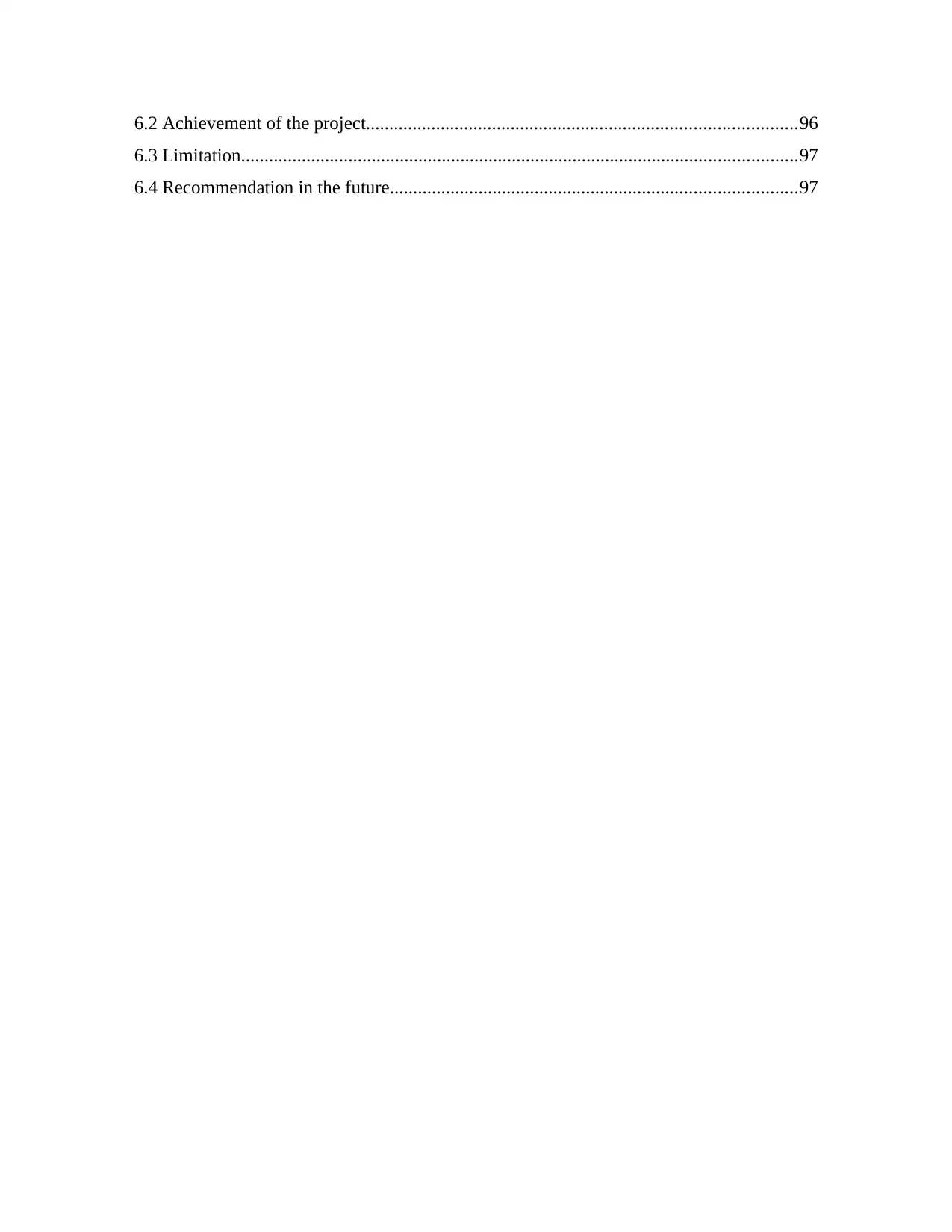
6.2 Achievement of the project............................................................................................96
6.3 Limitation.......................................................................................................................97
6.4 Recommendation in the future.......................................................................................97
6.3 Limitation.......................................................................................................................97
6.4 Recommendation in the future.......................................................................................97
⊘ This is a preview!⊘
Do you want full access?
Subscribe today to unlock all pages.

Trusted by 1+ million students worldwide
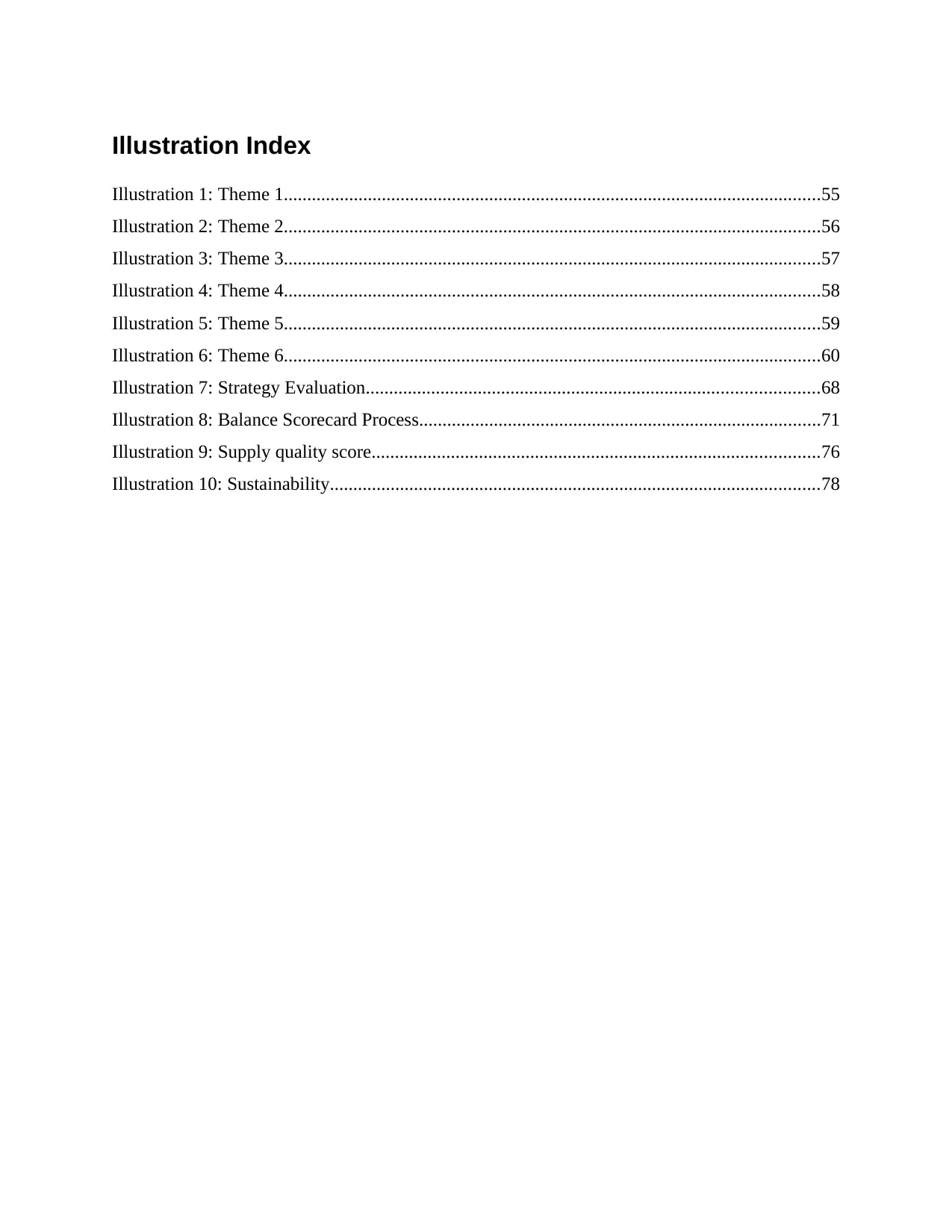
Illustration Index
Illustration 1: Theme 1...................................................................................................................55
Illustration 2: Theme 2...................................................................................................................56
Illustration 3: Theme 3...................................................................................................................57
Illustration 4: Theme 4...................................................................................................................58
Illustration 5: Theme 5...................................................................................................................59
Illustration 6: Theme 6...................................................................................................................60
Illustration 7: Strategy Evaluation.................................................................................................68
Illustration 8: Balance Scorecard Process......................................................................................71
Illustration 9: Supply quality score................................................................................................76
Illustration 10: Sustainability.........................................................................................................78
Illustration 1: Theme 1...................................................................................................................55
Illustration 2: Theme 2...................................................................................................................56
Illustration 3: Theme 3...................................................................................................................57
Illustration 4: Theme 4...................................................................................................................58
Illustration 5: Theme 5...................................................................................................................59
Illustration 6: Theme 6...................................................................................................................60
Illustration 7: Strategy Evaluation.................................................................................................68
Illustration 8: Balance Scorecard Process......................................................................................71
Illustration 9: Supply quality score................................................................................................76
Illustration 10: Sustainability.........................................................................................................78
Paraphrase This Document
Need a fresh take? Get an instant paraphrase of this document with our AI Paraphraser
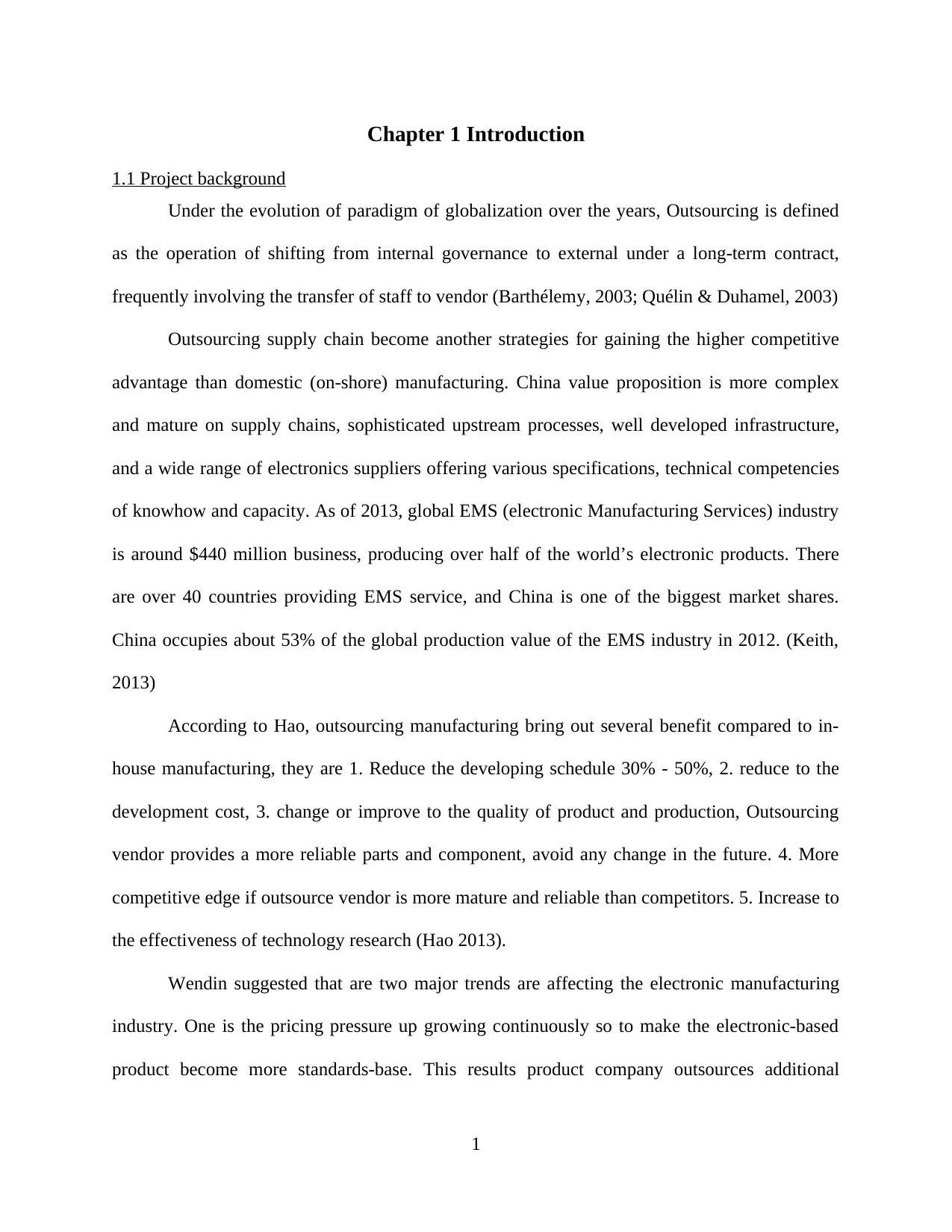
Chapter 1 Introduction
1.1 Project background
Under the evolution of paradigm of globalization over the years, Outsourcing is defined
as the operation of shifting from internal governance to external under a long-term contract,
frequently involving the transfer of staff to vendor (Barthélemy, 2003; Quélin & Duhamel, 2003)
Outsourcing supply chain become another strategies for gaining the higher competitive
advantage than domestic (on-shore) manufacturing. China value proposition is more complex
and mature on supply chains, sophisticated upstream processes, well developed infrastructure,
and a wide range of electronics suppliers offering various specifications, technical competencies
of knowhow and capacity. As of 2013, global EMS (electronic Manufacturing Services) industry
is around $440 million business, producing over half of the world’s electronic products. There
are over 40 countries providing EMS service, and China is one of the biggest market shares.
China occupies about 53% of the global production value of the EMS industry in 2012. (Keith,
2013)
According to Hao, outsourcing manufacturing bring out several benefit compared to in-
house manufacturing, they are 1. Reduce the developing schedule 30% - 50%, 2. reduce to the
development cost, 3. change or improve to the quality of product and production, Outsourcing
vendor provides a more reliable parts and component, avoid any change in the future. 4. More
competitive edge if outsource vendor is more mature and reliable than competitors. 5. Increase to
the effectiveness of technology research (Hao 2013).
Wendin suggested that are two major trends are affecting the electronic manufacturing
industry. One is the pricing pressure up growing continuously so to make the electronic-based
product become more standards-base. This results product company outsources additional
1
1.1 Project background
Under the evolution of paradigm of globalization over the years, Outsourcing is defined
as the operation of shifting from internal governance to external under a long-term contract,
frequently involving the transfer of staff to vendor (Barthélemy, 2003; Quélin & Duhamel, 2003)
Outsourcing supply chain become another strategies for gaining the higher competitive
advantage than domestic (on-shore) manufacturing. China value proposition is more complex
and mature on supply chains, sophisticated upstream processes, well developed infrastructure,
and a wide range of electronics suppliers offering various specifications, technical competencies
of knowhow and capacity. As of 2013, global EMS (electronic Manufacturing Services) industry
is around $440 million business, producing over half of the world’s electronic products. There
are over 40 countries providing EMS service, and China is one of the biggest market shares.
China occupies about 53% of the global production value of the EMS industry in 2012. (Keith,
2013)
According to Hao, outsourcing manufacturing bring out several benefit compared to in-
house manufacturing, they are 1. Reduce the developing schedule 30% - 50%, 2. reduce to the
development cost, 3. change or improve to the quality of product and production, Outsourcing
vendor provides a more reliable parts and component, avoid any change in the future. 4. More
competitive edge if outsource vendor is more mature and reliable than competitors. 5. Increase to
the effectiveness of technology research (Hao 2013).
Wendin suggested that are two major trends are affecting the electronic manufacturing
industry. One is the pricing pressure up growing continuously so to make the electronic-based
product become more standards-base. This results product company outsources additional
1
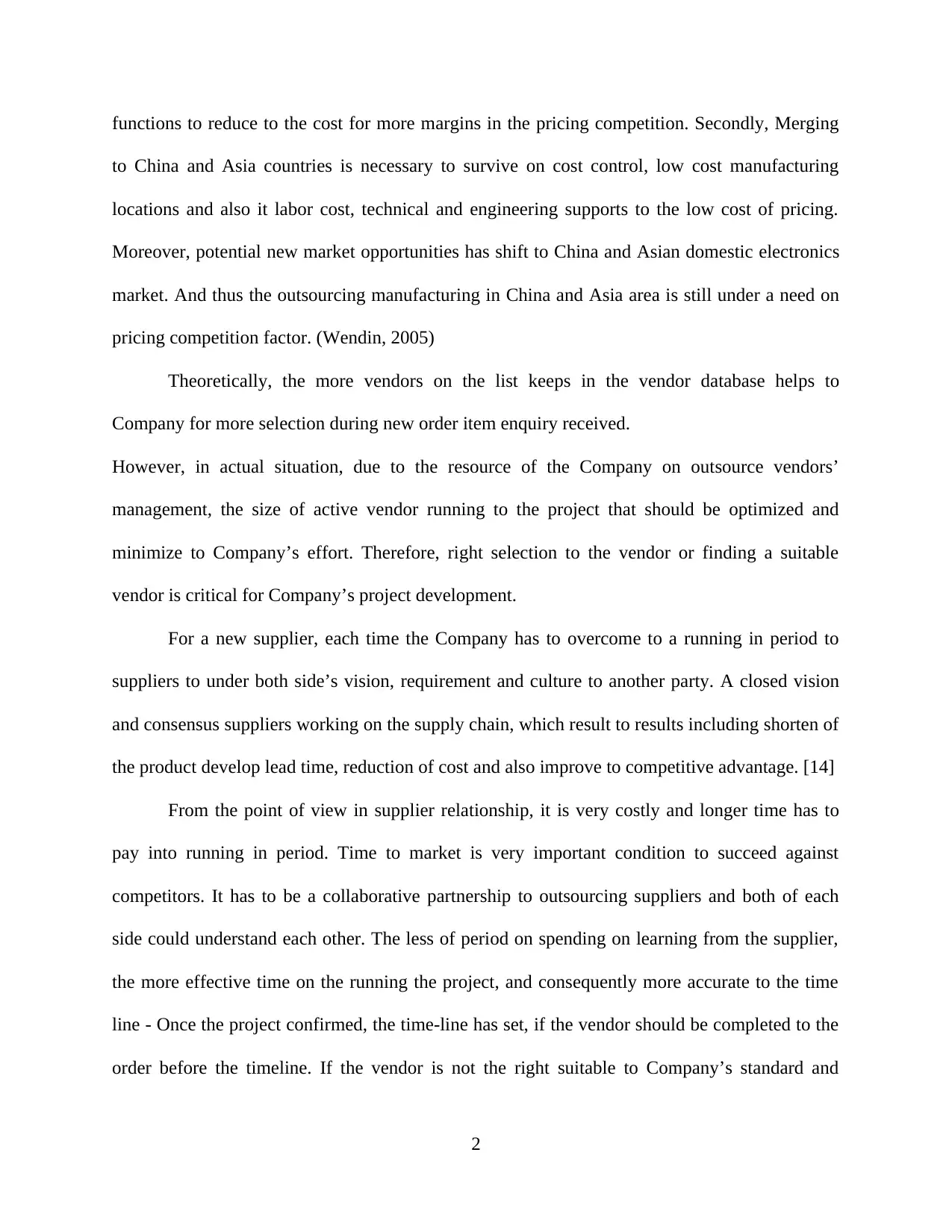
functions to reduce to the cost for more margins in the pricing competition. Secondly, Merging
to China and Asia countries is necessary to survive on cost control, low cost manufacturing
locations and also it labor cost, technical and engineering supports to the low cost of pricing.
Moreover, potential new market opportunities has shift to China and Asian domestic electronics
market. And thus the outsourcing manufacturing in China and Asia area is still under a need on
pricing competition factor. (Wendin, 2005)
Theoretically, the more vendors on the list keeps in the vendor database helps to
Company for more selection during new order item enquiry received.
However, in actual situation, due to the resource of the Company on outsource vendors’
management, the size of active vendor running to the project that should be optimized and
minimize to Company’s effort. Therefore, right selection to the vendor or finding a suitable
vendor is critical for Company’s project development.
For a new supplier, each time the Company has to overcome to a running in period to
suppliers to under both side’s vision, requirement and culture to another party. A closed vision
and consensus suppliers working on the supply chain, which result to results including shorten of
the product develop lead time, reduction of cost and also improve to competitive advantage. [14]
From the point of view in supplier relationship, it is very costly and longer time has to
pay into running in period. Time to market is very important condition to succeed against
competitors. It has to be a collaborative partnership to outsourcing suppliers and both of each
side could understand each other. The less of period on spending on learning from the supplier,
the more effective time on the running the project, and consequently more accurate to the time
line - Once the project confirmed, the time-line has set, if the vendor should be completed to the
order before the timeline. If the vendor is not the right suitable to Company’s standard and
2
to China and Asia countries is necessary to survive on cost control, low cost manufacturing
locations and also it labor cost, technical and engineering supports to the low cost of pricing.
Moreover, potential new market opportunities has shift to China and Asian domestic electronics
market. And thus the outsourcing manufacturing in China and Asia area is still under a need on
pricing competition factor. (Wendin, 2005)
Theoretically, the more vendors on the list keeps in the vendor database helps to
Company for more selection during new order item enquiry received.
However, in actual situation, due to the resource of the Company on outsource vendors’
management, the size of active vendor running to the project that should be optimized and
minimize to Company’s effort. Therefore, right selection to the vendor or finding a suitable
vendor is critical for Company’s project development.
For a new supplier, each time the Company has to overcome to a running in period to
suppliers to under both side’s vision, requirement and culture to another party. A closed vision
and consensus suppliers working on the supply chain, which result to results including shorten of
the product develop lead time, reduction of cost and also improve to competitive advantage. [14]
From the point of view in supplier relationship, it is very costly and longer time has to
pay into running in period. Time to market is very important condition to succeed against
competitors. It has to be a collaborative partnership to outsourcing suppliers and both of each
side could understand each other. The less of period on spending on learning from the supplier,
the more effective time on the running the project, and consequently more accurate to the time
line - Once the project confirmed, the time-line has set, if the vendor should be completed to the
order before the timeline. If the vendor is not the right suitable to Company’s standard and
2
⊘ This is a preview!⊘
Do you want full access?
Subscribe today to unlock all pages.

Trusted by 1+ million students worldwide
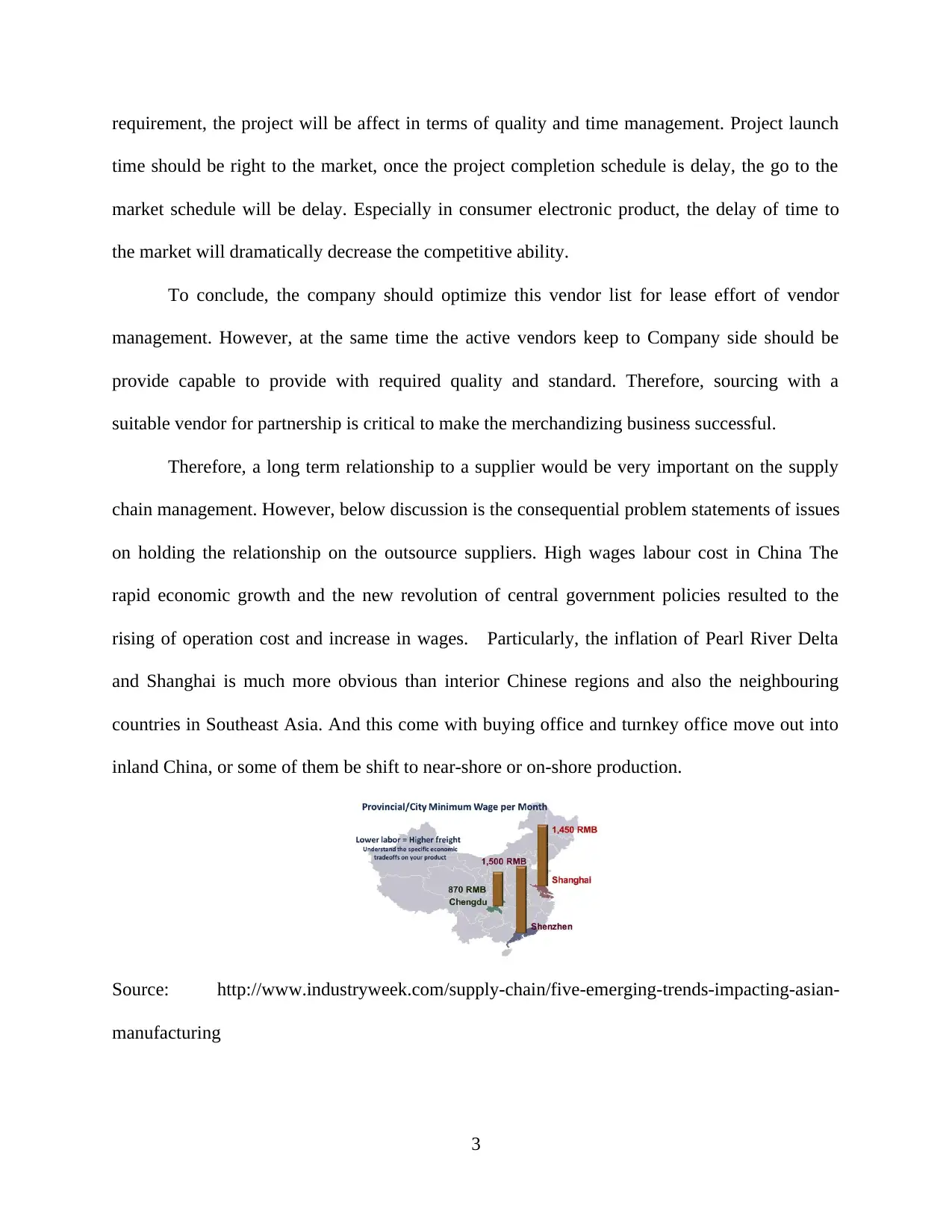
requirement, the project will be affect in terms of quality and time management. Project launch
time should be right to the market, once the project completion schedule is delay, the go to the
market schedule will be delay. Especially in consumer electronic product, the delay of time to
the market will dramatically decrease the competitive ability.
To conclude, the company should optimize this vendor list for lease effort of vendor
management. However, at the same time the active vendors keep to Company side should be
provide capable to provide with required quality and standard. Therefore, sourcing with a
suitable vendor for partnership is critical to make the merchandizing business successful.
Therefore, a long term relationship to a supplier would be very important on the supply
chain management. However, below discussion is the consequential problem statements of issues
on holding the relationship on the outsource suppliers. High wages labour cost in China The
rapid economic growth and the new revolution of central government policies resulted to the
rising of operation cost and increase in wages. Particularly, the inflation of Pearl River Delta
and Shanghai is much more obvious than interior Chinese regions and also the neighbouring
countries in Southeast Asia. And this come with buying office and turnkey office move out into
inland China, or some of them be shift to near-shore or on-shore production.
Source: http://www.industryweek.com/supply-chain/five-emerging-trends-impacting-asian-
manufacturing
3
time should be right to the market, once the project completion schedule is delay, the go to the
market schedule will be delay. Especially in consumer electronic product, the delay of time to
the market will dramatically decrease the competitive ability.
To conclude, the company should optimize this vendor list for lease effort of vendor
management. However, at the same time the active vendors keep to Company side should be
provide capable to provide with required quality and standard. Therefore, sourcing with a
suitable vendor for partnership is critical to make the merchandizing business successful.
Therefore, a long term relationship to a supplier would be very important on the supply
chain management. However, below discussion is the consequential problem statements of issues
on holding the relationship on the outsource suppliers. High wages labour cost in China The
rapid economic growth and the new revolution of central government policies resulted to the
rising of operation cost and increase in wages. Particularly, the inflation of Pearl River Delta
and Shanghai is much more obvious than interior Chinese regions and also the neighbouring
countries in Southeast Asia. And this come with buying office and turnkey office move out into
inland China, or some of them be shift to near-shore or on-shore production.
Source: http://www.industryweek.com/supply-chain/five-emerging-trends-impacting-asian-
manufacturing
3
Paraphrase This Document
Need a fresh take? Get an instant paraphrase of this document with our AI Paraphraser
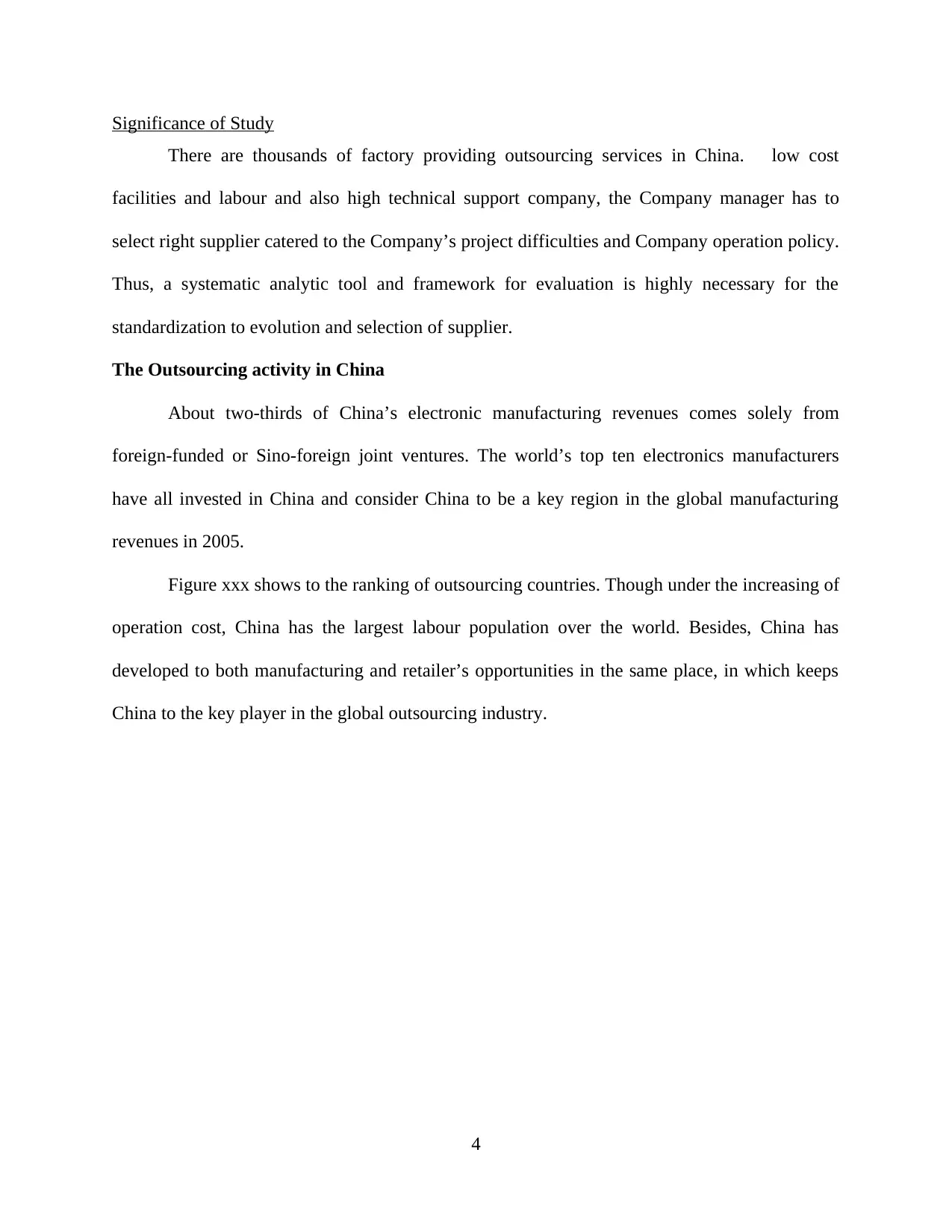
Significance of Study
There are thousands of factory providing outsourcing services in China. low cost
facilities and labour and also high technical support company, the Company manager has to
select right supplier catered to the Company’s project difficulties and Company operation policy.
Thus, a systematic analytic tool and framework for evaluation is highly necessary for the
standardization to evolution and selection of supplier.
The Outsourcing activity in China
About two-thirds of China’s electronic manufacturing revenues comes solely from
foreign-funded or Sino-foreign joint ventures. The world’s top ten electronics manufacturers
have all invested in China and consider China to be a key region in the global manufacturing
revenues in 2005.
Figure xxx shows to the ranking of outsourcing countries. Though under the increasing of
operation cost, China has the largest labour population over the world. Besides, China has
developed to both manufacturing and retailer’s opportunities in the same place, in which keeps
China to the key player in the global outsourcing industry.
4
There are thousands of factory providing outsourcing services in China. low cost
facilities and labour and also high technical support company, the Company manager has to
select right supplier catered to the Company’s project difficulties and Company operation policy.
Thus, a systematic analytic tool and framework for evaluation is highly necessary for the
standardization to evolution and selection of supplier.
The Outsourcing activity in China
About two-thirds of China’s electronic manufacturing revenues comes solely from
foreign-funded or Sino-foreign joint ventures. The world’s top ten electronics manufacturers
have all invested in China and consider China to be a key region in the global manufacturing
revenues in 2005.
Figure xxx shows to the ranking of outsourcing countries. Though under the increasing of
operation cost, China has the largest labour population over the world. Besides, China has
developed to both manufacturing and retailer’s opportunities in the same place, in which keeps
China to the key player in the global outsourcing industry.
4
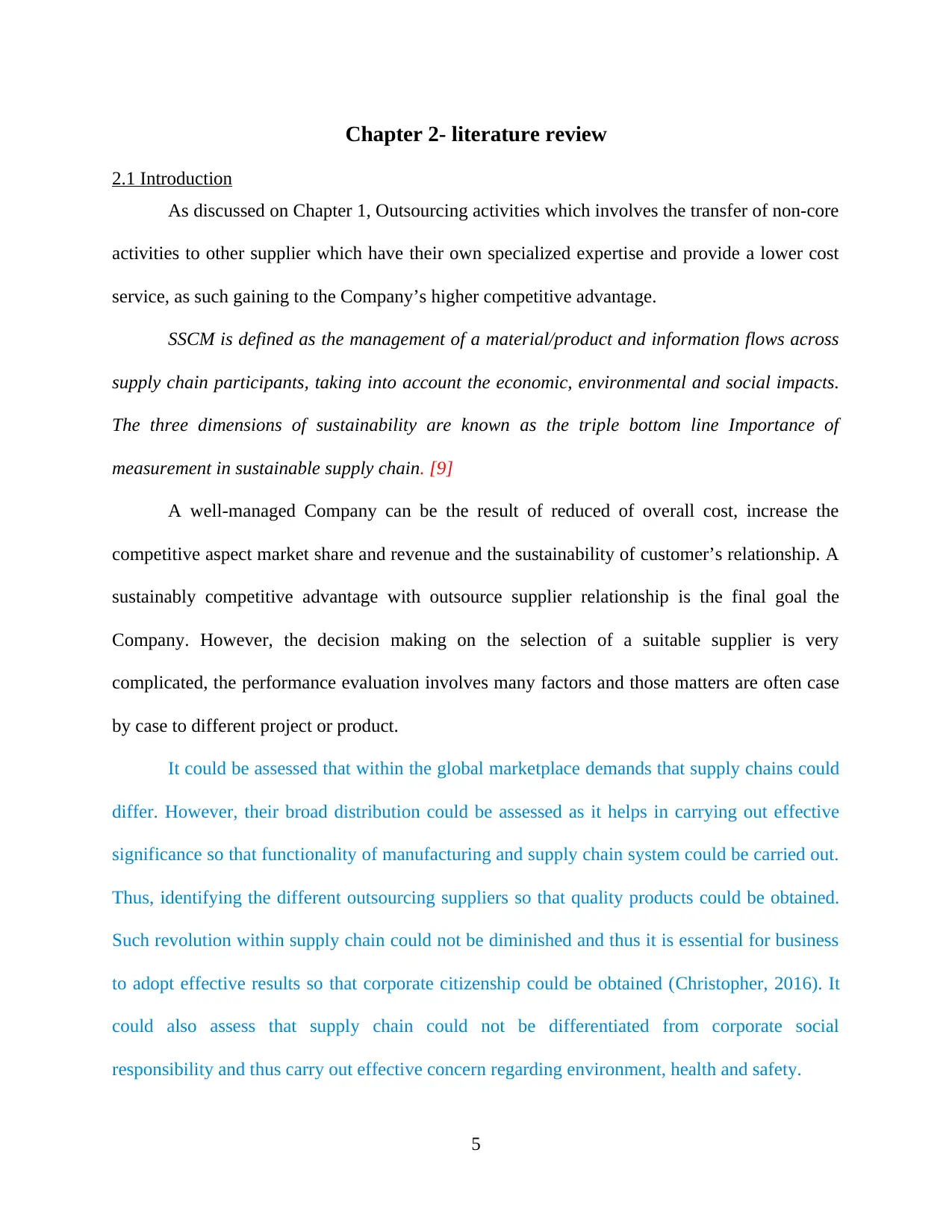
Chapter 2- literature review
2.1 Introduction
As discussed on Chapter 1, Outsourcing activities which involves the transfer of non-core
activities to other supplier which have their own specialized expertise and provide a lower cost
service, as such gaining to the Company’s higher competitive advantage.
SSCM is defined as the management of a material/product and information flows across
supply chain participants, taking into account the economic, environmental and social impacts.
The three dimensions of sustainability are known as the triple bottom line Importance of
measurement in sustainable supply chain. [9]
A well-managed Company can be the result of reduced of overall cost, increase the
competitive aspect market share and revenue and the sustainability of customer’s relationship. A
sustainably competitive advantage with outsource supplier relationship is the final goal the
Company. However, the decision making on the selection of a suitable supplier is very
complicated, the performance evaluation involves many factors and those matters are often case
by case to different project or product.
It could be assessed that within the global marketplace demands that supply chains could
differ. However, their broad distribution could be assessed as it helps in carrying out effective
significance so that functionality of manufacturing and supply chain system could be carried out.
Thus, identifying the different outsourcing suppliers so that quality products could be obtained.
Such revolution within supply chain could not be diminished and thus it is essential for business
to adopt effective results so that corporate citizenship could be obtained (Christopher, 2016). It
could also assess that supply chain could not be differentiated from corporate social
responsibility and thus carry out effective concern regarding environment, health and safety.
5
2.1 Introduction
As discussed on Chapter 1, Outsourcing activities which involves the transfer of non-core
activities to other supplier which have their own specialized expertise and provide a lower cost
service, as such gaining to the Company’s higher competitive advantage.
SSCM is defined as the management of a material/product and information flows across
supply chain participants, taking into account the economic, environmental and social impacts.
The three dimensions of sustainability are known as the triple bottom line Importance of
measurement in sustainable supply chain. [9]
A well-managed Company can be the result of reduced of overall cost, increase the
competitive aspect market share and revenue and the sustainability of customer’s relationship. A
sustainably competitive advantage with outsource supplier relationship is the final goal the
Company. However, the decision making on the selection of a suitable supplier is very
complicated, the performance evaluation involves many factors and those matters are often case
by case to different project or product.
It could be assessed that within the global marketplace demands that supply chains could
differ. However, their broad distribution could be assessed as it helps in carrying out effective
significance so that functionality of manufacturing and supply chain system could be carried out.
Thus, identifying the different outsourcing suppliers so that quality products could be obtained.
Such revolution within supply chain could not be diminished and thus it is essential for business
to adopt effective results so that corporate citizenship could be obtained (Christopher, 2016). It
could also assess that supply chain could not be differentiated from corporate social
responsibility and thus carry out effective concern regarding environment, health and safety.
5
⊘ This is a preview!⊘
Do you want full access?
Subscribe today to unlock all pages.

Trusted by 1+ million students worldwide
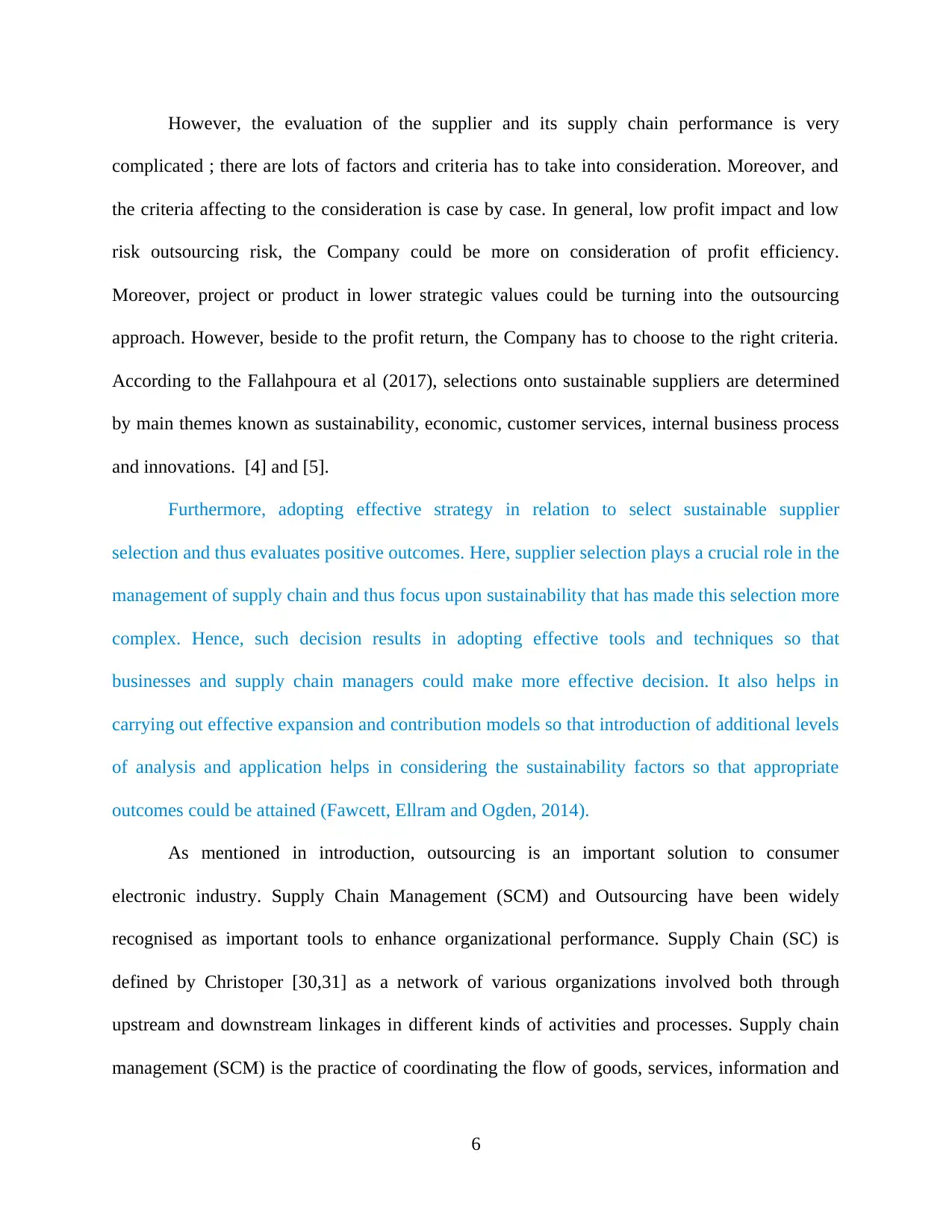
However, the evaluation of the supplier and its supply chain performance is very
complicated ; there are lots of factors and criteria has to take into consideration. Moreover, and
the criteria affecting to the consideration is case by case. In general, low profit impact and low
risk outsourcing risk, the Company could be more on consideration of profit efficiency.
Moreover, project or product in lower strategic values could be turning into the outsourcing
approach. However, beside to the profit return, the Company has to choose to the right criteria.
According to the Fallahpoura et al (2017), selections onto sustainable suppliers are determined
by main themes known as sustainability, economic, customer services, internal business process
and innovations. [4] and [5].
Furthermore, adopting effective strategy in relation to select sustainable supplier
selection and thus evaluates positive outcomes. Here, supplier selection plays a crucial role in the
management of supply chain and thus focus upon sustainability that has made this selection more
complex. Hence, such decision results in adopting effective tools and techniques so that
businesses and supply chain managers could make more effective decision. It also helps in
carrying out effective expansion and contribution models so that introduction of additional levels
of analysis and application helps in considering the sustainability factors so that appropriate
outcomes could be attained (Fawcett, Ellram and Ogden, 2014).
As mentioned in introduction, outsourcing is an important solution to consumer
electronic industry. Supply Chain Management (SCM) and Outsourcing have been widely
recognised as important tools to enhance organizational performance. Supply Chain (SC) is
defined by Christoper [30,31] as a network of various organizations involved both through
upstream and downstream linkages in different kinds of activities and processes. Supply chain
management (SCM) is the practice of coordinating the flow of goods, services, information and
6
complicated ; there are lots of factors and criteria has to take into consideration. Moreover, and
the criteria affecting to the consideration is case by case. In general, low profit impact and low
risk outsourcing risk, the Company could be more on consideration of profit efficiency.
Moreover, project or product in lower strategic values could be turning into the outsourcing
approach. However, beside to the profit return, the Company has to choose to the right criteria.
According to the Fallahpoura et al (2017), selections onto sustainable suppliers are determined
by main themes known as sustainability, economic, customer services, internal business process
and innovations. [4] and [5].
Furthermore, adopting effective strategy in relation to select sustainable supplier
selection and thus evaluates positive outcomes. Here, supplier selection plays a crucial role in the
management of supply chain and thus focus upon sustainability that has made this selection more
complex. Hence, such decision results in adopting effective tools and techniques so that
businesses and supply chain managers could make more effective decision. It also helps in
carrying out effective expansion and contribution models so that introduction of additional levels
of analysis and application helps in considering the sustainability factors so that appropriate
outcomes could be attained (Fawcett, Ellram and Ogden, 2014).
As mentioned in introduction, outsourcing is an important solution to consumer
electronic industry. Supply Chain Management (SCM) and Outsourcing have been widely
recognised as important tools to enhance organizational performance. Supply Chain (SC) is
defined by Christoper [30,31] as a network of various organizations involved both through
upstream and downstream linkages in different kinds of activities and processes. Supply chain
management (SCM) is the practice of coordinating the flow of goods, services, information and
6
Paraphrase This Document
Need a fresh take? Get an instant paraphrase of this document with our AI Paraphraser
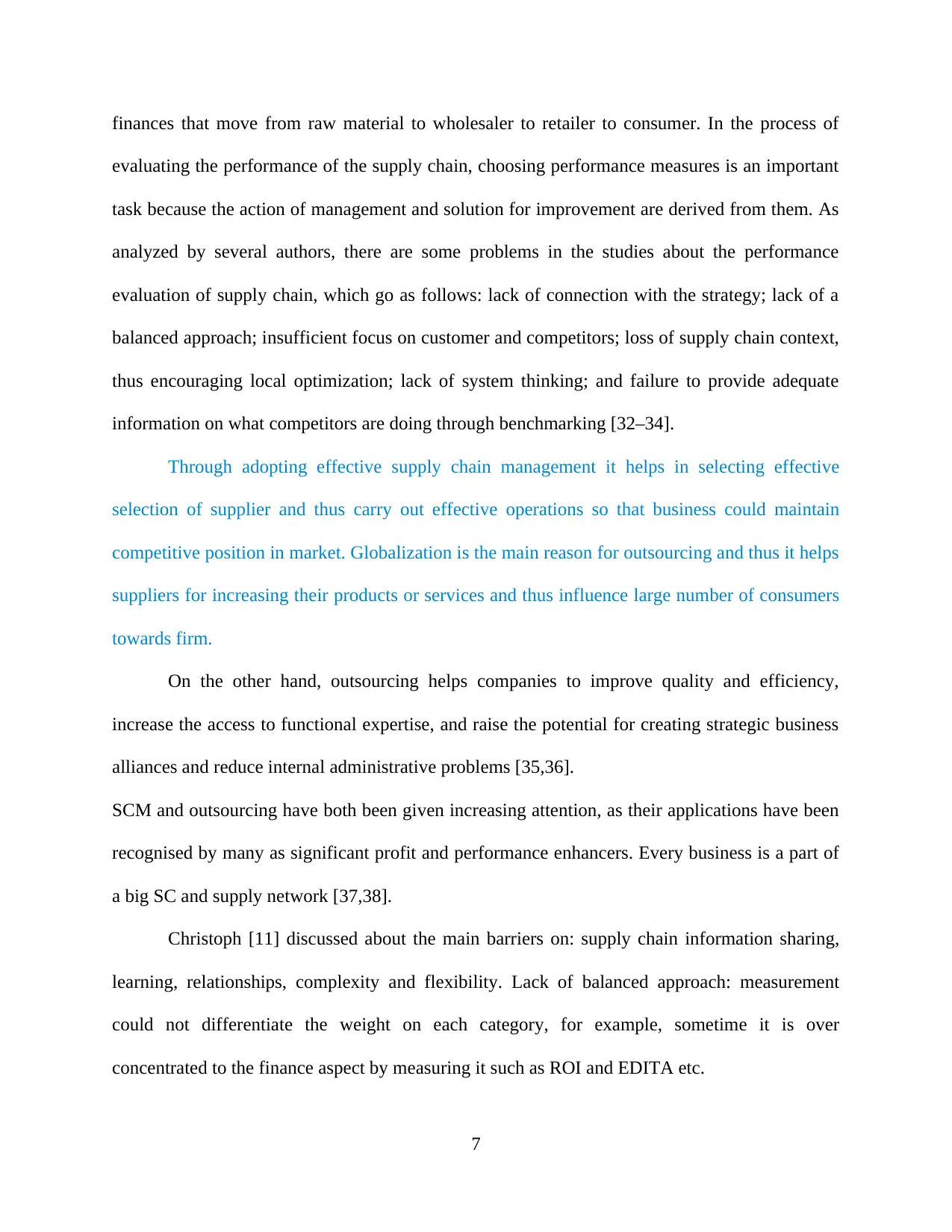
finances that move from raw material to wholesaler to retailer to consumer. In the process of
evaluating the performance of the supply chain, choosing performance measures is an important
task because the action of management and solution for improvement are derived from them. As
analyzed by several authors, there are some problems in the studies about the performance
evaluation of supply chain, which go as follows: lack of connection with the strategy; lack of a
balanced approach; insufficient focus on customer and competitors; loss of supply chain context,
thus encouraging local optimization; lack of system thinking; and failure to provide adequate
information on what competitors are doing through benchmarking [32–34].
Through adopting effective supply chain management it helps in selecting effective
selection of supplier and thus carry out effective operations so that business could maintain
competitive position in market. Globalization is the main reason for outsourcing and thus it helps
suppliers for increasing their products or services and thus influence large number of consumers
towards firm.
On the other hand, outsourcing helps companies to improve quality and efficiency,
increase the access to functional expertise, and raise the potential for creating strategic business
alliances and reduce internal administrative problems [35,36].
SCM and outsourcing have both been given increasing attention, as their applications have been
recognised by many as significant profit and performance enhancers. Every business is a part of
a big SC and supply network [37,38].
Christoph [11] discussed about the main barriers on: supply chain information sharing,
learning, relationships, complexity and flexibility. Lack of balanced approach: measurement
could not differentiate the weight on each category, for example, sometime it is over
concentrated to the finance aspect by measuring it such as ROI and EDITA etc.
7
evaluating the performance of the supply chain, choosing performance measures is an important
task because the action of management and solution for improvement are derived from them. As
analyzed by several authors, there are some problems in the studies about the performance
evaluation of supply chain, which go as follows: lack of connection with the strategy; lack of a
balanced approach; insufficient focus on customer and competitors; loss of supply chain context,
thus encouraging local optimization; lack of system thinking; and failure to provide adequate
information on what competitors are doing through benchmarking [32–34].
Through adopting effective supply chain management it helps in selecting effective
selection of supplier and thus carry out effective operations so that business could maintain
competitive position in market. Globalization is the main reason for outsourcing and thus it helps
suppliers for increasing their products or services and thus influence large number of consumers
towards firm.
On the other hand, outsourcing helps companies to improve quality and efficiency,
increase the access to functional expertise, and raise the potential for creating strategic business
alliances and reduce internal administrative problems [35,36].
SCM and outsourcing have both been given increasing attention, as their applications have been
recognised by many as significant profit and performance enhancers. Every business is a part of
a big SC and supply network [37,38].
Christoph [11] discussed about the main barriers on: supply chain information sharing,
learning, relationships, complexity and flexibility. Lack of balanced approach: measurement
could not differentiate the weight on each category, for example, sometime it is over
concentrated to the finance aspect by measuring it such as ROI and EDITA etc.
7
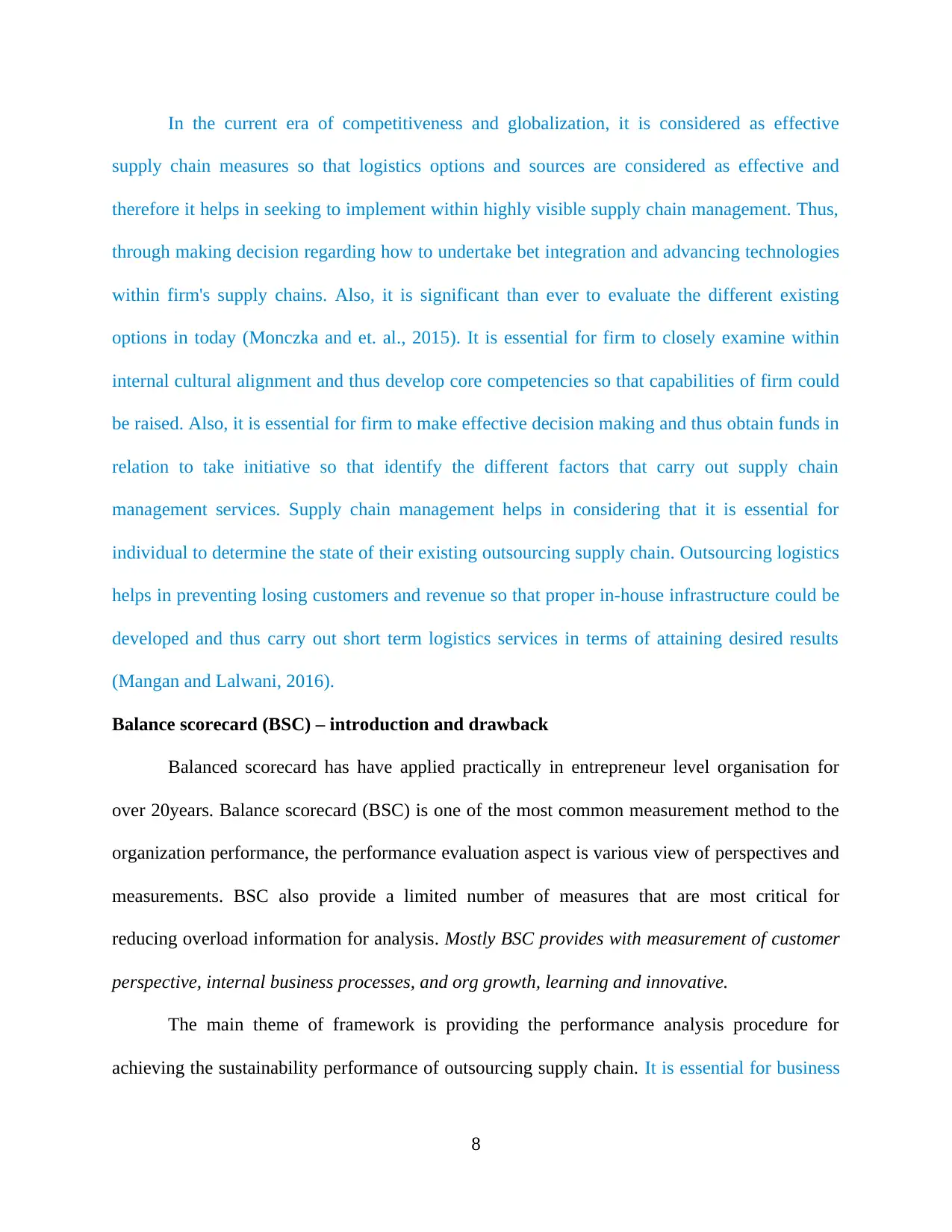
In the current era of competitiveness and globalization, it is considered as effective
supply chain measures so that logistics options and sources are considered as effective and
therefore it helps in seeking to implement within highly visible supply chain management. Thus,
through making decision regarding how to undertake bet integration and advancing technologies
within firm's supply chains. Also, it is significant than ever to evaluate the different existing
options in today (Monczka and et. al., 2015). It is essential for firm to closely examine within
internal cultural alignment and thus develop core competencies so that capabilities of firm could
be raised. Also, it is essential for firm to make effective decision making and thus obtain funds in
relation to take initiative so that identify the different factors that carry out supply chain
management services. Supply chain management helps in considering that it is essential for
individual to determine the state of their existing outsourcing supply chain. Outsourcing logistics
helps in preventing losing customers and revenue so that proper in-house infrastructure could be
developed and thus carry out short term logistics services in terms of attaining desired results
(Mangan and Lalwani, 2016).
Balance scorecard (BSC) – introduction and drawback
Balanced scorecard has have applied practically in entrepreneur level organisation for
over 20years. Balance scorecard (BSC) is one of the most common measurement method to the
organization performance, the performance evaluation aspect is various view of perspectives and
measurements. BSC also provide a limited number of measures that are most critical for
reducing overload information for analysis. Mostly BSC provides with measurement of customer
perspective, internal business processes, and org growth, learning and innovative.
The main theme of framework is providing the performance analysis procedure for
achieving the sustainability performance of outsourcing supply chain. It is essential for business
8
supply chain measures so that logistics options and sources are considered as effective and
therefore it helps in seeking to implement within highly visible supply chain management. Thus,
through making decision regarding how to undertake bet integration and advancing technologies
within firm's supply chains. Also, it is significant than ever to evaluate the different existing
options in today (Monczka and et. al., 2015). It is essential for firm to closely examine within
internal cultural alignment and thus develop core competencies so that capabilities of firm could
be raised. Also, it is essential for firm to make effective decision making and thus obtain funds in
relation to take initiative so that identify the different factors that carry out supply chain
management services. Supply chain management helps in considering that it is essential for
individual to determine the state of their existing outsourcing supply chain. Outsourcing logistics
helps in preventing losing customers and revenue so that proper in-house infrastructure could be
developed and thus carry out short term logistics services in terms of attaining desired results
(Mangan and Lalwani, 2016).
Balance scorecard (BSC) – introduction and drawback
Balanced scorecard has have applied practically in entrepreneur level organisation for
over 20years. Balance scorecard (BSC) is one of the most common measurement method to the
organization performance, the performance evaluation aspect is various view of perspectives and
measurements. BSC also provide a limited number of measures that are most critical for
reducing overload information for analysis. Mostly BSC provides with measurement of customer
perspective, internal business processes, and org growth, learning and innovative.
The main theme of framework is providing the performance analysis procedure for
achieving the sustainability performance of outsourcing supply chain. It is essential for business
8
⊘ This is a preview!⊘
Do you want full access?
Subscribe today to unlock all pages.

Trusted by 1+ million students worldwide
1 out of 105
Your All-in-One AI-Powered Toolkit for Academic Success.
+13062052269
info@desklib.com
Available 24*7 on WhatsApp / Email
![[object Object]](/_next/static/media/star-bottom.7253800d.svg)
Unlock your academic potential
Copyright © 2020–2025 A2Z Services. All Rights Reserved. Developed and managed by ZUCOL.